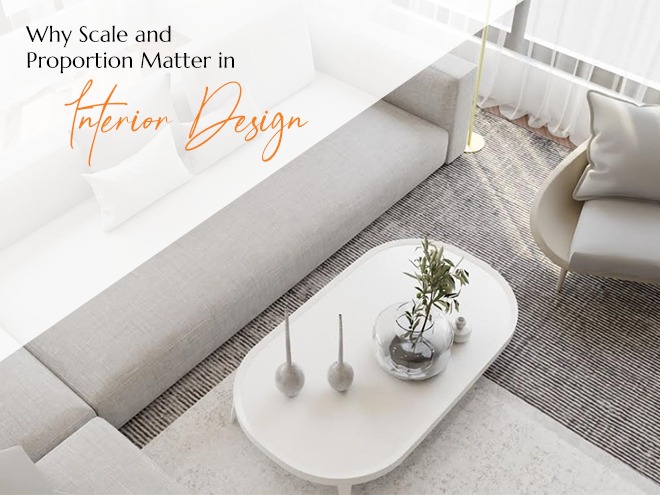Why Scale and Proportion Matter in Interior Design
Scale and proportion are two design concepts that quietly shape how a space looks and feels yet most people mix them up. Here’s the simple difference: scale is about how big or small something is as compared to the room itself. While proportion is about how items relate in size to one another.
Getting both of these right is key to creating a space that feels natural & balanced. When furniture, lighting, artwork and decor are chosen with the right scale and proportion, the space flows better.
Scale vs. Proportion
Scale refers to the size of an object as compared to the size of the room. For eg, a huge sectional sofa might look great online but in a small apartment, it could occupy the entire space.
Proportion, on the other hand, is about how pieces relate to each other. For eg, imagine a tall, heavy bookcase kept next to a tiny chair, it might feel off. That’s a bad proportion.
Designers constantly adjust both to create harmony. When done right, the room feels balanced. When done wrong, even expensive furniture can make the space feel awkward.
Poor scaling is one of the most common design mistakes people make, mainly because they often buy pieces they like without considering how they’ll function in their space.
Why Scale and Proportion Directly Impact Functionality and Well-being
Scale and proportion affect how you move through your home, how open or tight a room feels & even your mental comfort in the space. Rooms with proper scale & spacing help in lowering stress levels, especially in high-functioning areas like living rooms, kitchens, and office spaces.
In New Jersey, where space varies from tight condos to wide suburban homes, scale becomes even more important. Oversized furniture in small homes can lead to constant bumping, clutter & irritation. In larger homes, under-scaled pieces often make rooms feel cold and incomplete.
In commercial spaces like boutiques, clinics, or offices, wrong proportions can mess with flow, accessibility, and even client impressions. That is why working with a New Jersey luxury interior designer who truly understands these principles can make a measurable difference.
How Designers Use Scale and Proportion
- Vertical scale is adjusted using drapes, tall art, or lighting to draw the eye upward in low-ceiling rooms
- Negative space is intentionally left around objects so they “breathe.” Too much furniture creates visual stress
- A good designer anchors a room using a focal point (like a statement sofa or art piece), and then builds proportionate elements around it
- Even small details like matching the diameter of a dining table to the room shape can change the entire look of a space
In personalized projects, especially in Best Living Room Design setups, an interior designer looks at your lifestyle, traffic flow, habits & even posture preferences before choosing furniture.
Why Getting It Right Matters
If you’re planning to redesign your home or office in New Jersey, scale and proportion should be priority. They don’t just influence how your space looks, they affect how it feels, functions, and moves with time.
At Avantte Interiors, we treat these principles as non-negotiables. Our team doesn’t just focus on what looks good. We dive deep into what works, what fits your lifestyle & what will stand the test of time in your home or workplace. With years of experience working across a wide range of styles & spaces, we know how to strike the right balance between beauty, comfort, and usability.
When you work with us, you’re trusting one of the most experienced & best interior designers in NJ. We bring the insight, precision, and care needed to make your space truly reflect who you are.


